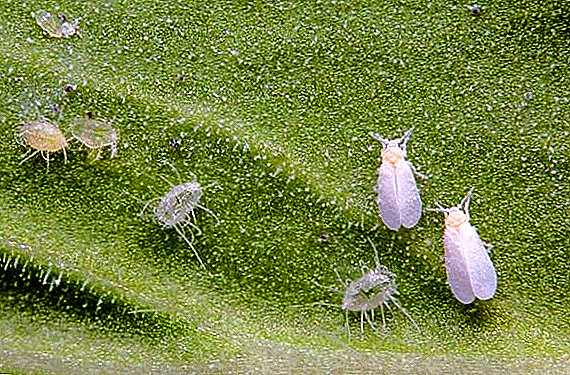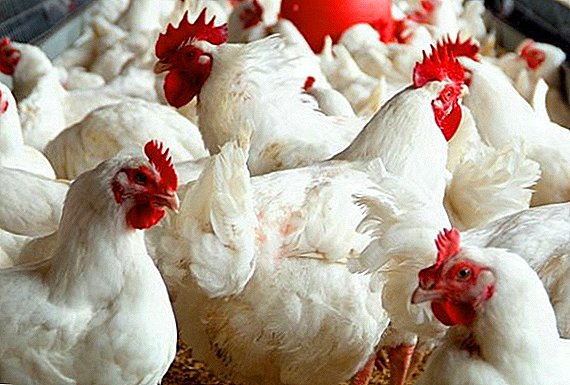 Grow healthy chickens hybrid breeds without antibiotic therapy is impossible. After all, this poultry is very sensitive to infectious diseases. Therefore, breeders need to start preventive measures in a timely manner. However, any antibiotics require the strictest adherence to the recommended dosage and regimen. Why should chicks be given such drugs, how to do it correctly and which names should be given preference - read all this further in the article.
Grow healthy chickens hybrid breeds without antibiotic therapy is impossible. After all, this poultry is very sensitive to infectious diseases. Therefore, breeders need to start preventive measures in a timely manner. However, any antibiotics require the strictest adherence to the recommended dosage and regimen. Why should chicks be given such drugs, how to do it correctly and which names should be given preference - read all this further in the article.
What are antibiotics for broiler chickens?
The main purpose of antibacterial drugs is to suppress or destroy pathogenic microflora in the body. Their illiterate use can have a destructive effect on the internal organs and systems.
Important! To prevent viral infections, youngsters can be sealed with a live vaccine. The first time they do it at the age of ten days, the second time at 20-25 days of age.
And if you feed the chicks with too small doses, the pathogens will soon adapt to antibiotics and become invincible. Abuse of such drugs is fraught with mucous membranes and other serious complications. Therefore, the therapeutic and prophylactic effect depends largely on the dose taken.
Video: use of antibiotics in growing broilers Crosses of hens, to which broilers have been credited, are distinguished by a very sensitive digestive tract and low acidity of the stomach. Due to their physiological characteristics, they do not produce the necessary amount of enzymes. In addition, this bird cannot independently control its body temperature, and the chicks are vulnerable to negative environmental factors.
Learn more about the Cobb-700, Cobb-500, ROSS-708 and ROSS-308 broiler crosses.
Many poultry farmers are afraid to use antibacterial drugs for fattening meat breeds. But it often happens that the pathogenic environment grows with such speed that the breeder does not have time to take timely measures and subsequently loses livestock.
Proceeding from this, veterinarians advise from the first days of life to give hybrid chicks vitamins and glucose, and from the week of age to begin antibiotic therapy. When choosing drugs should take into account the range of their actions. Thus, the pathogenic bacteria that have entered the body will not be able to attach to the epithelial layers and will not multiply. 
What broad spectrum antibiotics can be given to broilers
In order to decide on the choice of antibiotic medicines, it is important when buying broiler chickens to find out from the seller, than the young were vaccinated before and whether it was drunk with something.
Also it is necessary to take into account the age category of chicks, because due to the separate content each of them has its own unique microflora. Let's take a closer look at the preferred modern preparations recommended for cross-country chickens at all stages of maturation.
For daily broilers
Considering the ability of pathogenic microorganisms to mutate rapidly, today the usual tetracycline antibacterial drugs are already a thing of the past.  They were replaced by new and more effective means, to which the pathogenic environment has not yet developed immunity:
They were replaced by new and more effective means, to which the pathogenic environment has not yet developed immunity:
- "Furazolidone";
- "Levomitsetin";
- "Streptomycin";
- "Chlortetracycline";
- "Baytril";
- "Enrofloks";
- "Monlar";
- "Koktsisan".
It will be useful for you to read about how to incubate broilers, what broiler chickens look like, how to raise broiler chickens at home, how to feed broiler chickens correctly, and what are the norms of broiler weight during all periods of life.
For older chickens
Crosses do not hold for a long time, because they grow very quickly, gaining weight, and this is attractive for poultry farms, as well as private farms. One and a half chickens are considered to be grown up, therefore, by this age, breeders try to minimize the intake of strong medicines up to 2 times a month. 
Older chickens should be given:
- "Biomitsin";
- "Penicillin";
- "Streptomycin";
- Metronidazole;
- "Trichopol";
- Dolink;
- "Kolivet";
- "Tilan";
- "Eriprim";
- "Kolimitsin";
- Imequil.
We recommend that you familiarize yourself with the broiler chickens feeding system with antibiotics and vitamins, and also find out what vitamins to give to broiler chickens and what should be included in the veterinary first aid kit for broiler chickens.
How to give antibiotics to broilers
According to experts, newborn chickens should drink vitamin-glucose mixtures for a week, and already from the 8-11th day of their life antibiotics can be given. This is due to the fact that initially chicks still have sterile microflora in the intestine.  To form a strong immunity will allow vitamins and a balanced diet, so these aspects need to be given special attention. Consider separately the features of each drug.
To form a strong immunity will allow vitamins and a balanced diet, so these aspects need to be given special attention. Consider separately the features of each drug.
"Furazolidone"
Many veterinarians consider this medicine non-toxic and prescribe it for prophylactic and therapeutic purposes in the very early stages of the chicks. From two weeks of age, they can mix the drug in drinking from salmonellosis, colibacillosis and other infections of bacterial origin.
Important! The use of antibiotics and vitamins for growth retardation syndromes, brittle bones does not have a positive effect. Such chicks should be discarded and set aside in a separate section for further proper care.The dosage is calculated in proportion of 3 g of antibiotic per 1 kg of live weight. The therapeutic course lasts 5-8 days, depending on the degree of infection.
 As a preventive measure, broilers are shown a continuous three-day reception with a further weekly break and subsequent repetition. Between the use of the drug, it is desirable for 5 days to give the chicks vitamins.
As a preventive measure, broilers are shown a continuous three-day reception with a further weekly break and subsequent repetition. Between the use of the drug, it is desirable for 5 days to give the chicks vitamins."Levomitsetin"
This drug is one of the most effective in the treatment of:
- salmonellosis;
- leptospirosis;
- pasteurellosis;
- colibacillosis and other infectious diseases in chickens.
Read more about the symptoms and treatment of infectious and non-infectious diseases in broiler chickens.
Veterinarians advise using it from the first week of life for treatment and prevention. The therapeutic course lasts 5 days according to the scheme of three daily meals. A single dose is calculated in the ratio of 5 mg per kilogram of live weight.  For prophylactic purposes, an antibiotic can be taken no more than 3 days. Otherwise, possible damage to the mucous membranes of the body. A feature of this medication is good digestibility and long-term excretion from the body. That is why it is preferable to choose the means for treatment.
For prophylactic purposes, an antibiotic can be taken no more than 3 days. Otherwise, possible damage to the mucous membranes of the body. A feature of this medication is good digestibility and long-term excretion from the body. That is why it is preferable to choose the means for treatment.
"Chlortetracycline"
The antibiotic is developed to combat mycoplasmosis and preventive measures. It is a light-colored antibacterial powder used to prepare a suspension for drinking. A single dosage, according to the manufacturer's instructions, assumes 40 mg of the drug for each kilogram of live weight.
Did you know? Among modern chicken breeds, Chinese silk is considered the most fluffy, which is a hybrid of rabbit and chicken. Its peculiarity lies in the presence of 5 fingers, fluffy feathers with increased hairiness, and also black skin..It is important to dilute it with a small amount of liquid and use it immediately. The recommended scheme provides for 3 receptions during the day course of 7 days. If the positive trend is not observed, you can extend the treatment for another 2-3 days.
 For the prevention of antibiotic drink 5 days with simultaneous intake of probiotics, aimed at improving the intestinal microflora. Be careful with the calculations of the desired portion, because the manufacturer does not exclude allergic reactions as side effects.
For the prevention of antibiotic drink 5 days with simultaneous intake of probiotics, aimed at improving the intestinal microflora. Be careful with the calculations of the desired portion, because the manufacturer does not exclude allergic reactions as side effects."Baytril"
The drug is respected by veterinarians because it has a wide spectrum of action. He is able to save poultry from a dozen different kinds of infections caused by Salmonella, Escherichia, Mycoplasma, Shigella, Bacteroid, Clostridium and Hemophilus bacteria in 3 days.
Did you know? Scientists are inclined to believe that the chickens are the only now existing descendants of tyrannosaurs.These pathogens can provoke:
- rhinitis;
- bronchitis;
- conjunctivitis;
- enteritis;
- severe dysbacteriosis.

It is recommended to use the drug for weekly broilers at a dosage of 50 ml per 100 l of water. For households, veterinarians are advised to buy the drug "Baytril 10" and dissolve 0.5 ml of the substance in 1 liter. The amount of medication is prepared based on the needs of chicks to drink. It is important that only antibacterial suspension is available in the drinkers during this period.
The minimum prophylactic and therapeutic course lasts 3 days. In cases of serious illnesses, drinking is given for 5 days. If the expected improvement did not occur during the specified period, the antibiotic should be changed.
Important! The best probiotics of the new generation are: “Albuvir”, “Baikal”, “Immunohepatophyte”, “Subtisporin”, “Chiktonik”. These preparations consist of beneficial microorganisms that have a beneficial effect on the processes occurring in the gastrointestinal tract of animals and birds.
Enroxil
The drug is widely known in the poultry industry, as it is one of the most recommended in the treatment of infectious diseases in domestic birds.  Such pathogenic microbes as: Mycoplasma, Bordetella, Escherichia, Corynebacterium, Clostridium, Proteus, Salmonella, Streptococcus, Staphylococcus, Klebsiella, Pseudomonad, Campylobacter, Pasteurella.
Such pathogenic microbes as: Mycoplasma, Bordetella, Escherichia, Corynebacterium, Clostridium, Proteus, Salmonella, Streptococcus, Staphylococcus, Klebsiella, Pseudomonad, Campylobacter, Pasteurella.
We advise you to read about where to start breeding broilers, why broilers do not grow, how to feed broilers properly, why broilers fall to their feet, and what to do when broilers sneeze, wheeze and cough.
In practice, most often the drug is treated:
- salmonellosis;
- coligranulomatosis;
- bronchitis;
- hemophilia;
- pasteurellosis;
- infectious sinusitis.
To chickens who have not turned 4 weeks since the day of hatching, dissolve 5 ml of the preparation in 10 l of water. The prophylactic course lasts 3 days, and in case of signs of the disease it is recommended to give a drink for 5 days. In the latter case, the dosage is increased to 3 ml and the amount of water is halved.  To strengthen the immune system, experts prescribe a 5 percent solution of Enroxil from the very first days of life. In this case, you need to prepare the medicine in the proportion of 1 ml per 1 liter of water.
To strengthen the immune system, experts prescribe a 5 percent solution of Enroxil from the very first days of life. In this case, you need to prepare the medicine in the proportion of 1 ml per 1 liter of water.
Did you know? In the tomb of Tutankhamen were found drawings of chickens and roosters, which indicates the respectful attitude of the ancient Egyptians to this bird.
"Monlar"
The medicine is a small, yellowish-brown granule that does not dissolve in water with a specific odor. Its active ingredients are effective in countering all types of coccidia that parasitize birds. Therefore, an antibiotic is prescribed for the treatment and prevention of coccidiosis in cross-country chickens and maintenance young chickens.
The active components of the antibacterial agent are considered moderately toxic to warm-blooded animals. Excreted from the body after 3 days along with feces.  From the first days of life, broiler chickens are recommended to mix the drug in the proportion of 1000-1250 g per ton of feed. And for young stock, the maximum dosage should not exceed 1200 g. The course of treatment lasts 5 days.
From the first days of life, broiler chickens are recommended to mix the drug in the proportion of 1000-1250 g per ton of feed. And for young stock, the maximum dosage should not exceed 1200 g. The course of treatment lasts 5 days.
Did you know? Japanese scientists from the National Institute of Advanced Industrial Science and Technology (AIST) bred genetically modified chickens that carry eggs that contain protein interferon beta. This drug is used in the treatment of cancer, multiple sclerosis, hepatitis and other serious diseases. According to experts, this scientific breakthrough will significantly reduce the price of interferon beta, which is currently in Japan up to 100 thousand yen (888 US dollars) for a few micrograms.
The negative effects of overdose on broiler antibiotics
Improper dosage of antibiotics can lead to bird toxicity. It is advisable not to allow such situations, but if this has already happened, it will be necessary to remove antibacterial agents from the poisoned organism as soon as possible.  In this case, as a rule, the following symptoms are observed:
In this case, as a rule, the following symptoms are observed:
- loss of appetite and complete failure to feed;
- lack of coordination of movements;
- lethargy;
- drowsiness;
- diarrhea;
- decrease in motor activity.
To this end, you need:
- Using probiotics to restore the intestinal microflora.
- Adjust the power. During this period, it is better to feed the chicks with cottage cheese, well pressed from whey, ryazhenka or yogurt and provide abundant drink to the wards (it is unacceptable that stagnant water should be in the drinking bowl).
- Arrange chicks access to outdoor walking and fresh greenery.
- Enrich the nutritional diet of broilers with meat and bone and vitamin supplements.
 Hybrid breeds of chickens are very dependent on humans and external factors, so it is very difficult to grow them to adulthood without medicines.
Hybrid breeds of chickens are very dependent on humans and external factors, so it is very difficult to grow them to adulthood without medicines.Important! The course of antibiotic therapy is stopped for 2-3 weeks to slaughter chickens.Immunity of organisms vulnerable to the pathogenic environment must constantly be maintained, destroying conditions favorable for the reproduction of bacteria. If you correctly calculate the dosage and stop antibiotic therapy in time, the potential harm to broilers will be excluded.












